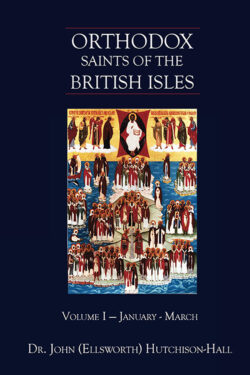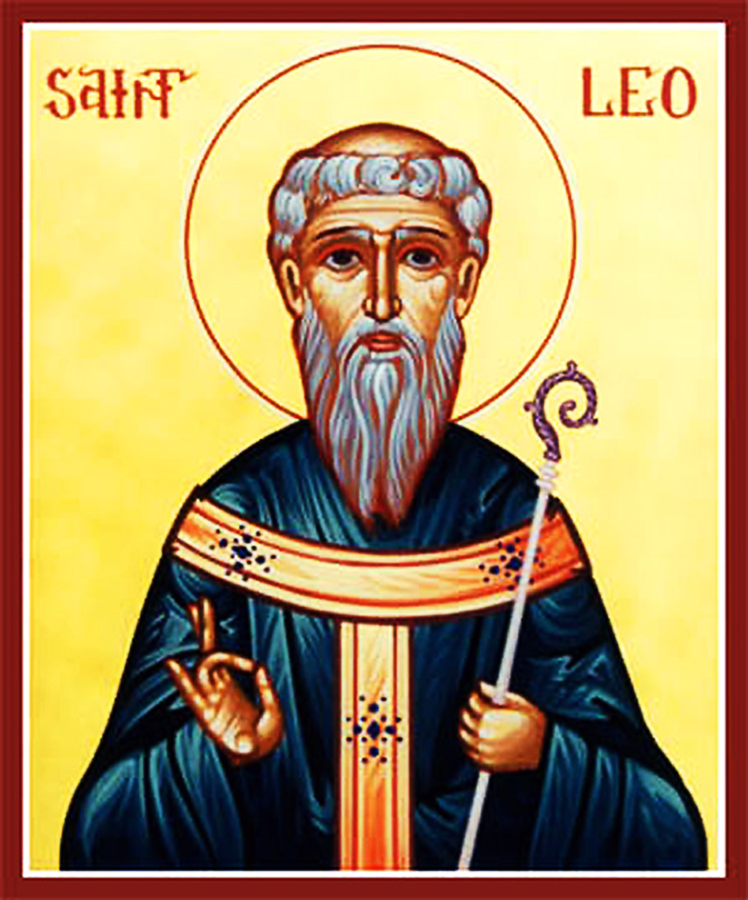
Orthodox Saints of the Pre-Schism
See of Rome
20th February (NS) — 7th February (OS) 2024
AMOLVIN (AMULWINUS) , Abbot-Bishop of the Abbey of St. Peter of Lobbes (l'abbaye Saint-Pierre de Lobbes) from 737, when he succeeded St. Erminus (25th April), until his repose circa 750. St. Amolvin's relics are enshrined at Binche in the present-day Belgian province of Hainaut.
ANATOLIUS, (Date Unknown), said to have been a mid-fifth century Bishop of Cahors in Gaul. However, there is no mention of him in the either the Gallia christiana nor in the Fastes Épiscopaux de l’ancienne Gaule, with the exception of a note where, the author, Roman Catholic Priest and Critical Historian Louis Duchesne (†1922), posits that St. Anatolius was the invention of Jesuit priest and theologian Victor de Buck, who introduced St. Anatolius in the Acta Sanctorum Octobris Tomus IX.
AUGULUS (AUGURIUS, AULE), (Fourth Century), as with so many saints of his era, there is little in the way of reliable information of his life extant. The Martyrology of St. Jerome lists St. Augulus as a bishop, whilst other ancient authorities describe him as a martyr who laid down his life for Christ in London. This would have been during the Diocletianic Persecution in which St. Alban (22nd June) suffered circa 303. It is possible St. Augulus was not a saint of the British Isles, as he has also been identified by some French authorities with St. Ouil or Aule of Normandy.
CHRYSOLIUS, (Date Unknown), an Armenian who travelled to Gaul and Flanders to evangelise the region. St. Chrysolius was, at some point after his arrival in Flanders, consecrated bishop. Though his travel from Armenia to Flanders was during the Diocletianic Persecution, St. Chrysolius managed to avoid any persecution by Roman authorities. However, he as martyred by pagans in Flanders. St. Chrysolius' relics were enshrined at St. Donatian's Church in Bruges in present-day Belgium.
FIDELIS, a Greek, who as part of a merchant venture, settled in Mérida in the early to mid-sixth century. Once there, he became a disciple of Paul, Bishop of that city (according to some sources St. Fidelis was Paul's nephew), whom he later succeeded. St. Fidelis reposed circa 570.
JULIANA of BOLOGNA, a matron in Bologna whose husband, with her consent, left her to become a priest. Having successfully raised her children, St. Juliana dedicated the rest of her life to service to the Church and poor. Her work was praised by St. Ambrose of Milan (7th December). St. Juliana reposed in 435.
LAURENCE of SIPONTO, also called St. Lorenzo Maiorano, he was Bishop of Siponto in Puglia from 492 until his repose circa 546. Following a series of visions of the Archangel Michael on Mount Gargano, St. Laurence built a shrine to the Archangel on the mountain.
MELDON (MEDON), (Sixth Century), an Irish hermit in Gaul. Nothing is known about St. Meldon beyond his repose at Péronne, and the existence of several churches in the area which are dedicated to him.
RICHARD, he appears to have been an Anglo-Saxon chieftain or Under-King in Wessex, most likely of a part of Devonshire. Married to a relative of St. Boniface (5th June), the Apostle of Germany, King St. Richard was the father of three Saints: SS. Willibald (7th July), Winebald (18th December), and Walburga (25th February). St. Richard reposed in 722 at Lucca in Tuscany whilst on a pilgrimage to Rome. Many miracles, the details of which are now lost to us, testified to his sanctity.
TRESSAN (TRÉSAIN), a missionary from Ireland who was ordained to the priesthood by St. Remigius (1st October). St. Tressan worked tirelessly to bring Christ to the people of the Champagne region of present-day France. He reposed in 550, and he has been venerated continuously in the area around Reims for over 1,000 years.
Get your copy of Orthodox Saints of the British Isles today.
Available at Amazon or your favourite e-bookstore.
BOLCAN (OLCAN), St. Bolcan was baptised by St. Patrick (17th March), who then sent him to study in Gaul. After his return to Ireland, St. Patrick consecrated him Bishop of Derkan (which was most likely near Armoy) in Ulster. St. Bolcan also founded a school in his See, which was one of the most eminent of its day. He reposed circa 480.
COLGAN, a renowned Abbot of Clonmacnoise, and one of the many of his era called ‘the Wise’, St. Colgan was also called ‘the Chief Scribe of the Irish’. He was a friend of the eminent Anglo-Saxon scholar/educator Alcuin of York (†804) and venerated as a saint even during his lifetime. Some of the prayers he composed are still extant. St. Colgan reposed circa 796.
ELEUTHERIUS of TOURNAI, generally considered to have been the first Bishop of his native city of Tournai (in present-day Belgium). Following his consecration St. Eleutherius worked to eradicate the Arian heresy from his See. The Arians responded by killing him in 532. St. Eleutherius’ relics are enshrined in the cathedral of Notre-Dame de Tournai.
EUCHERIUS, a native of Orléans and an extremely educated and God-fearing youth. St. Eucherius received monastic tonsure at the Abbey of St. Peter of Jumièges (l'abbaye Saint-Pierre de Jumièges) in Normandy circa 714. Following the repose of his uncle Suaveric in 721, St. Eucherius was consecrated his successor as Bishop of Orléans. However, conflict with Mayor of the Palace of Austrasia Charles Martel (†741) over the expropriation of church properties led to his exile to Cologne. Initially warmly welcomed in Cologne, St. Eucherius was later exiled to Hesbaye in present-day Belgium, living at St. Trudo's Abbey until his repose in 743.
FALCO, a Bishop of Maastricht who, according to tradition, ruled that See from 495 until his repose in 512.
LEO of CATANIA, known in Sicily as 'St. Leo the Wonderworker'; St. Leo was an eighth century Bishop of Catania in Sicily. His ardent opposition to the iconoclastic policy of Byzantine Emperor Leo III the Isaurian (r. 717–741) led to an order of arrest being issued for St. Leo. He fled to the mountains where he lived the rest of his life as a hermit. St. Leo reposed in 787.
Troparion of
St. Leo of Catania
Tone I
You were shown forth as a resplendent priest,
a teacher of godliness and a wonderworker, blessed hierarch Leo;
by the light of heavenly virtue you were enriched with the power of the Spirit,
and heal the souls and bodies of those who hasten to you.
Glory to Christ who has glorified you!
Glory to Him who has crowned you!
Glory to Him who through you works healing for all!
Kontakion of
St. Leo of Catania
Tone II
With hymns of praise let us crown Leo,
who was consecrated to the Lord from early childhood;
he received grace while still a babe in swaddling clothes.
He is a brightly shining star in the Church:
its valiant defender and firm support!
VALERIUS, (Date Unknown), said by St. Gregory of Tours (17th November) to have been the first Bishop of Couserans in Gascony.
Prior to the Schism the Patriarchate of Rome was Orthodox, and fully in communion with the Orthodox Church. As Saint John of Shanghai and San Francisco +1966 said “The West was Orthodox for a thousand years, and her venerable Liturgy is far older than any of her heresies”.
Details of British Saints excerpted from Orthodox Saints of the British Isles.
Details of continental saints from these sources.
In many cases there are several spelling versions of the names of saints from the British Isles. I use the Oxford Dictionary of National Biography version as the primary version with the more prevalent version in parenthesis e.g. Ceadda (Chad) of Lichfield.




